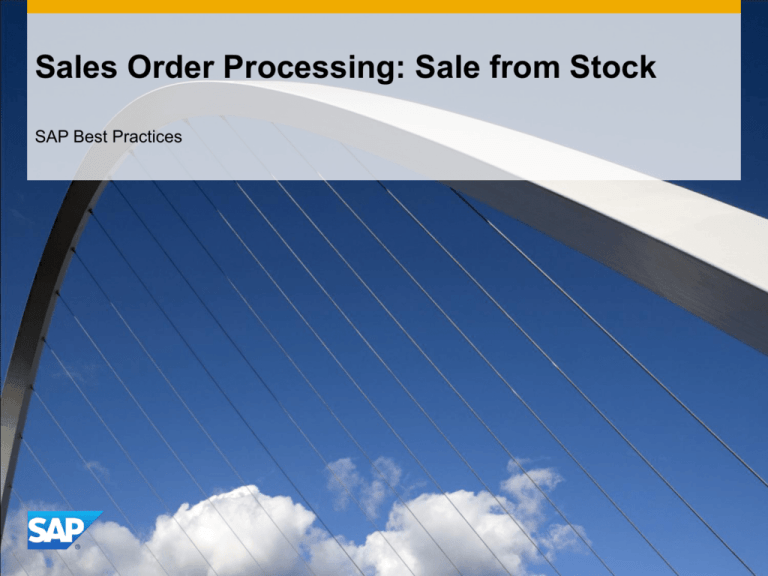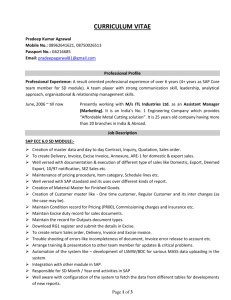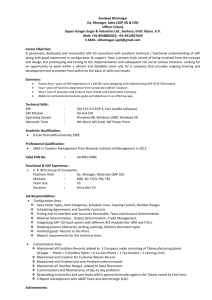
Sales Order Processing: Sale from Stock
SAP Best Practices
This scenario include two parts:
Sales from Factories
Sales from Depots
© 2012 SAP AG. All rights reserved.
‹#›
Purpose, Benefits, and Key Process Steps
Scenario Overview – Sales from Factories 1
Purpose
This scenario describes the entire process sequence for a standard sales process (Sale
from Factories) with a customer. The business process encompasses all steps from
creating an order to the clearing of a customer account after payment is received.
Benefits
When an order is entered, an availability check is performed and a shipping point is
determined automatically
A billing document is created and postings to FI and CO are made
Key process flows covered
•
•
•
•
•
•
•
Create sales order
Order confirmation
Delivery
Picking
Goods issue
Billing
Excise Invoice
© 2012 SAP AG. All rights reserved.
‹#›
Required SAP Applications and Company Roles
Required SAP Applications
Enhancement package 5 for SAP ERP 6.0
Company Roles
•
•
•
•
Sales Administrator
Warehouse Clerk
Billing Administrator
Excise Clerk
© 2012 SAP AG. All rights reserved.
‹#›
Detailed Process Description
Sales Order Processing: Sale from Factory
The process starts with the creation of a customer's standard sales order. Depending on the customer
and the material, various special events take place during order entry, such as customer/material
pricing, insertion of applicable discounts, checking the availability of the materials, and checking the
customer‘s credit history.
It is checked if enough material exists in the required storage location. If not, a stock movement takes
Place. Then, the picking slips are generated to the warehouse clerks to stage the product for shipment
to the customer.
Once picked, the physically shipped quantity has to be registered in the system to ensure that there are
no differences between the sales order and the delivery document. In case of actual differences, this
can also be documented and it ensures correct postings.
After the completion of picking, the warehouse clerk will have to systematically relieve the inventory.
This relief of inventory is the actual recording of the physical quantity that is being shipped to the
customer. This results in the recording of the cost of goods sold in financial accounting.
Once the inventory has been relieved, the delivery can be invoiced and the revenue, together with the
cost of goods sold, is recorded in management accounting. This step signifies the end of the business
transaction in Sales and Distribution.
The next step of this document describes how invoices are posted, customer statements are prepared
and printed, and the incoming payments are recorded, and then cleared to make sure that the open
customer account balance is reconciled.
Excise Payable entry is posted.
© 2012 SAP AG. All rights reserved.
‹#›
Process Flow Diagram
Sales Order Processing: Sale from Stock-Manufactory
Customer
Needs to Buy
Product
Credit
Management
(108)
Credit
Management
(108)
Customer
Event
(Optional)
Sales
Quotation
(112)
Delivery Note
Billing
Document
Sales Order
Entry
Excise
Clerk
Accounts
Receivable
Accountant
Billing
Adminis Warehouse Clerk
trator
Sales
Administr
ator
Order
Confirmation
Delivery Due
List
Check Batches
/ Assign Serial
Number
(optional)
Post Goods
Issue
Inventory
COGS
Pick List
Billing
AR–Incoming
Payment
(157)
Sales: Period
End Closing
Operations
(203)
Excise Payable
Excise
Invoice
AR= Accounts Receivable, COGS = Cost of Goods Sold
© 2012 SAP AG. All rights reserved.
‹#›
Purpose, Benefits, and Key Process Steps
Scenario Overview – Sales from Depots 1
Purpose
This scenario describes the entire process sequence for a standard sales process (Sale
from Depot Stock) with a customer. The business process encompasses all steps from
creating an stock transfer order/ Purchase order to the clearing of a customer account
after payment is received.
Benefits
When an order is entered, an availability check is performed and a shipping point is
determined automatically
A billing document is created and postings to FI and CO are made
Key process flows covered
•
•
•
•
•
•
Stock transfer to Depot for finish goods to Capture Excise
Goods receipt according to Purchase Order for trading goods Capture Excise
Sales order at depot
Delivery at depot
Excise invoice at depot
Commercial invoice at Depot
© 2012 SAP AG. All rights reserved.
‹#›
Required SAP Applications and Company Roles
Required SAP Applications
Enhancement package 5 for SAP ERP 6.0
Company Roles
•
•
•
•
Sales Administrator
Warehouse Clerk
Billing Administrator
Excise Clerk
© 2012 SAP AG. All rights reserved.
‹#›
Detailed Process Description
Sales Order Processing: Sale from Depot
• The Depot sales process starts with creation of stock transfer order or
•
•
•
•
•
•
•
purchase order to create stock of required material at depot for further sale
according to customer requirement.
If stock at Depot is created with STO from Depot to manufacturing plant , then
delivery and picking is performed at manufacturing plant. Performa invoice is
create with ref. to delivery. Excise invoice is created with ref. to Performa
invoice to crate excise payable entry at manufacturing plant.
If stock at Depot is created with PO to vendor , them purchase order from depot
is created for required amount of stock.
Material is received at Depot with ref. to delivery at manufacturing plant or PO
to vendor and excise values are captured .
Once stock is built up at depot, sales order for sale from depot is created
according to customer requirement.
Delivery of material is created with ref. to sales order.
Excise invoice is created for delivery at depot.
Commercial invoice is created with ref. to delivery at depot.
© 2012 SAP AG. All rights reserved.
‹#›
Process Flow Diagram
Sales Order Processing: Sale from Stock-Depots
Customer
Needs to Buy
Product
Credit
Management
(108)
Credit
Management
(108)
Customer
Event
(Optional)
Sales
Quotation
(112)
Billing
Document
Delivery Note
Sales Order
Entry
Stock
Transfer
with Delivery
(134)
Check Batches
/ Assign Serial
Number
(optional)
Delivery Due
List
Procurement
without QM
(130)
Excise
Clerk
© 2012 SAP AG. All rights reserved.
AR= Accounts Receivable, COGS = Cost of Goods Sold
Post Goods
Issue
Inventory
COGS
Pick List
Billing
Accounts
Receivable
Accountant
Billing
Adminis Warehouse Clerk
trator
Sales
Administr
ator
Order
Confirmation
AR–Incoming
Payment
(157)
Excise Payable
Sales: Period
End Closing
Operations
(203)
Excise
Invoice
‹#›
Legend
<Function>
Symbol
Description
Usage Comments
Band: Identifies a user role, such as Accounts
Payable Clerk or Sales Representative. This band
can also identify an organization unit or group,
rather than a specific role.
Role band contains
tasks common to that
role.
Symbol
Diagram
Connection
The other process flow symbols in this table go
into these rows. You have as many rows as
required to cover all of the roles in the scenario.
External
to SAP
External Events: Contains events that start or end
the scenario, or influence the course of events in
the scenario.
Business
Activity / Event
SubProcess
Reference
Process
Decision
Flow line (solid): Line indicates the normal sequence
of steps and direction of flow in the scenario.
Flow line (dashed): Line indicates flow to
infrequently-used or conditional tasks in a
scenario. Line can also lead to documents involved
in the process flow.
Connects two tasks in
a scenario process or
a non-step event
Business Activity / Event: Identifies an action that
either leads into or out of the scenario, or an
outside Process that happens during the scenario
Does not correspond
to a task step in the
document
Unit Process: Identifies a task that is covered in a
step-by-step manner in the scenario
Corresponds to a task
step in the document
To next / From last Diagram: Leads
to the next / previous page of the
Diagram
Flow chart continues on the next /
previous page
Hardcopy / Document: Identifies a
printed document, report, or form
Does not correspond to a task
step in a document; instead, it is
used to reflect a document
generated by a task step; this
shape does not have any outgoing
flow lines
Financial Actuals: Indicates a
financial posting document
Does not correspond to a task
step in a document; instead, it is
used to reflect a document
generated by a task step; this
shape does not have any outgoing
flow lines
Budget Planning: Indicates a
budget planning document
Does not correspond to a task
step in a document; instead, it is
used to reflect a document
generated by a task step; this
shape does not have any outgoing
flow lines
Manual Process: Covers a task
that is manually done
Does not generally correspond to
a task step in a document;
instead, it is used to reflect a task
that is manually performed, such
as unloading a truck in the
warehouse, which affects the
process flow.
Existing Version / Data: This block
covers data that feeds in from an
external process
Does not generally correspond to
a task step in a document;
instead, this shape reflects data
coming from an external source;
this step does not have any
incoming flow lines
System Pass / Fail Decision: This
block covers an automatic
decision made by the software
Does not generally correspond to
a task step in the document;
instead it is used to reflect an
automatic decision by the system
that is made after a step has been
executed.
Financial
Actuals
Process Reference: If the scenario references
another scenario in total, put the scenario number
and name here.
Corresponds to a task
step in the document
Sub-Process Reference: If the scenario references
another scenario in part, put the scenario number,
name, and the step numbers from that scenario
here
Corresponds to a task
step in the document
Process Decision: Identifies a decision / branching
point, signifying a choice to be made by the end
user. Lines represent different choices emerging
from different parts of the diamond.
Does not usually
correspond to a task
step in the document;
Reflects a choice to
be made after step
execution
© 2012 SAP AG. All rights reserved.
Usage Comments
Hardcopy /
Document
Budget
Planning
Unit Process
Process
Reference
Description
Manual
Process
Existing
Version /
Data
System
Pass/Fail
Decision
‹#›
© 2012 SAP AG. All rights reserved
No part of this publication may be reproduced or transmitted in any form or for any purpose
without the express permission of SAP AG. The information contained herein may be
changed without prior notice.
Some software products marketed by SAP AG and its distributors contain proprietary
software components of other software vendors.
Microsoft, Windows, Excel, Outlook, PowerPoint, Silverlight, and Visual Studio are
registered trademarks of Microsoft Corporation.
IBM, DB2, DB2 Universal Database, System i, System i5, System p, System p5, System x,
System z, System z10, z10, z/VM, z/OS, OS/390, zEnterprise, PowerVM, Power
Architecture, Power Systems, POWER7, POWER6+, POWER6, POWER, PowerHA,
pureScale, PowerPC, BladeCenter, System Storage, Storwize, XIV, GPFS, HACMP,
RETAIN, DB2 Connect, RACF, Redbooks, OS/2, AIX, Intelligent Miner, WebSphere, Tivoli,
Informix, and Smarter Planet are trademarks or registered trademarks of IBM Corporation.
Linux is the registered trademark of Linus Torvalds in the United States and other countries.
Adobe, the Adobe logo, Acrobat, PostScript, and Reader are trademarks or registered
trademarks of Adobe Systems Incorporated in the United States and other countries.
Oracle and Java are registered trademarks of Oracle and its affiliates.
UNIX, X/Open, OSF/1, and Motif are registered trademarks of the Open Group.
Citrix, ICA, Program Neighborhood, MetaFrame, WinFrame, VideoFrame, and MultiWin are
trademarks or registered trademarks of Citrix Systems Inc.
HTML, XML, XHTML, and W3C are trademarks or registered trademarks of W3C®, World
Wide Web Consortium, Massachusetts Institute of Technology.
Apple, App Store, iBooks, iPad, iPhone, iPhoto, iPod, iTunes, Multi-Touch, Objective-C,
Retina, Safari, Siri, and Xcode are trademarks or registered trademarks of Apple Inc.
IOS is a registered trademark of Cisco Systems Inc.
INTERMEC is a registered trademark of Intermec Technologies Corporation.
Wi-Fi is a registered trademark of Wi-Fi Alliance.
Bluetooth is a registered trademark of Bluetooth SIG Inc.
Motorola is a registered trademark of Motorola Trademark Holdings LLC.
Computop is a registered trademark of Computop Wirtschaftsinformatik GmbH.
SAP, R/3, SAP NetWeaver, Duet, PartnerEdge, ByDesign, SAP BusinessObjects Explorer,
StreamWork, SAP HANA, and other SAP products and services mentioned herein as well
as their respective logos are trademarks or registered trademarks of SAP AG in Germany
and other countries.
Business Objects and the Business Objects logo, BusinessObjects, Crystal Reports, Crystal
Decisions, Web Intelligence, Xcelsius, and other Business Objects products and services
mentioned herein as well as their respective logos are trademarks or registered trademarks
of Business Objects Software Ltd. Business Objects is an
SAP company.
Sybase and Adaptive Server, iAnywhere, Sybase 365, SQL Anywhere, and other Sybase
products and services mentioned herein as well as their respective logos are trademarks or
registered trademarks of Sybase Inc. Sybase is an SAP company.
Crossgate, m@gic EDDY, B2B 360°, and B2B 360° Services are registered trademarks
of Crossgate AG in Germany and other countries. Crossgate is an SAP company.
All other product and service names mentioned are the trademarks of their respective
companies. Data contained in this document serves informational purposes only. National
product specifications may vary.
The information in this document is proprietary to SAP. No part of this document may be
reproduced, copied, or transmitted in any form or for any purpose without the express prior
written permission of SAP AG.
RIM, BlackBerry, BBM, BlackBerry Curve, BlackBerry Bold, BlackBerry Pearl, BlackBerry
Torch, BlackBerry Storm, BlackBerry Storm2, BlackBerry PlayBook, and BlackBerry App
World are trademarks or registered trademarks of Research in Motion Limited.
Google App Engine, Google Apps, Google Checkout, Google Data API, Google Maps,
Google Mobile Ads, Google Mobile Updater, Google Mobile, Google Store, Google Sync,
Google Updater, Google Voice, Google Mail, Gmail, YouTube, Dalvik and Android are
trademarks or registered trademarks of Google Inc.
© 2012 SAP AG. All rights reserved.
‹#›







